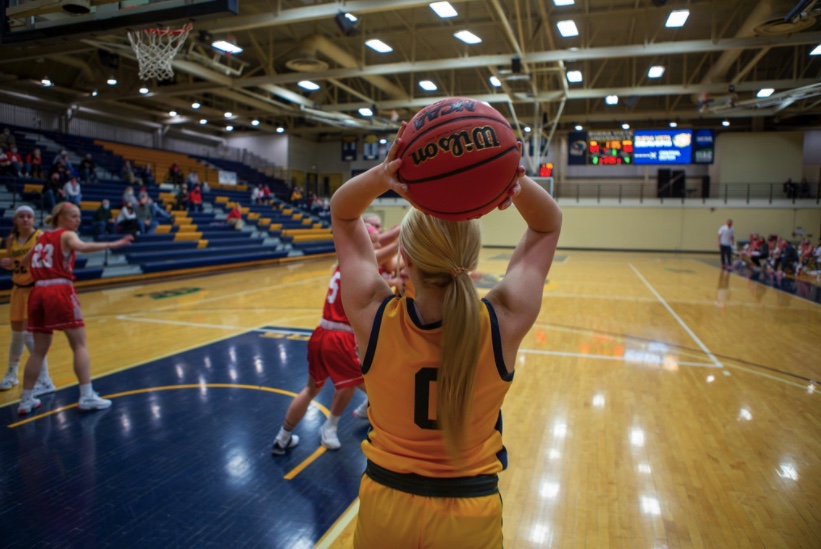Opinion: Inequalities between womens and mens sports become prominent during March Madness
Credit: Courtesy of BVU athletics via Flickr
WSPN’s Sophia Oppenheim discusses the discrepancy between the facilities at the women’s and men’s Division 1 basketball tournaments.
The men’s and women’s Division 1 basketball tournaments, otherwise known as March Madness, have just concluded. Each tournament’s teams demonstrated vast talent and teamwork. However, the teams in the women’s tournament received half of the NCAA-provided amenities that the men did. This situation was first brought to my attention after Oregon Ducks forward Sedona Prince released a viral TikTok showing the differences between their weight rooms.
Multiple people were upset with the discrepancy because it was obvious that the men were receiving more advantages. After doing more research, I found even more injustices that upset me. Not only was there a large equipment difference in the weight room provided for each tournament, but the women also received inadequate meal sizes and fewer product-filled swag bags. The men’s weight room had multiple rows of weights and machines. The women’s weight room, however, had only a small rack of weights, a yoga mat and a table provided to them. The women’s meals came in small containers holding only small portions of food. On the other hand, the men were served a full buffet. The swag bags also had way fewer products inside them for the women. This may seem small, but to create an equal bag with the same amount of products seems extremely simple.
It could be argued that the men have a better facility because they bring in more money. However, the NCAA said that there was less equipment given because there wasn’t enough space. In Prince’s video, she shows large amounts of space in both the women’s and men’s weight rooms, more than enough for more equipment. The NCAA did report that the rest of their weight room had been made into a COVID-19 team waiting area, making it so that they could not provide the women with more equipment. The NCAA realized that people were not going to settle for their unfair weight rooms and decided to provide the women’s teams that entered the Sweet 16 with more equipment. Why did it take nearly 50 teams to be eliminated before upgrading the rest to a reasonable weight room?
No matter how many spectators follow and watch the men’s tournament compared to the women’s tournament, members of each tournament worked hard to get to the level they are at today. This makes it unfair that the women are receiving much fewer amenities than the men just because men are bringing in more money to the organization.
These injustices are easily found in multiple different places. Recently, my dad and I watched a “60 Minutes” episode where sportswriter Dave Kindred reveals that he recently took up writing for a high school girls basketball team after covering famous athletes like Muhammad Ali for years.
The state championship-winning team he covers, the Potters, is the girls basketball team at Morton High School in Central Illinois. For more than a decade, Kindred has been writing about each basketball game the girls play after periodically showing up to just watch for years before. Now, it has become a routine for him to write a briefing after each game because he believes that he owes it to the girls to write for them because of Title IX. Kindred has written for 300 of the Potters’ games, more than he ever did his whole career before. In the “60 Minutes” episode, the Potters’ team members share that if the boys basketball team had won their state tournament, the town would celebrate for weeks and hang a banner, however, the girls team received no recognition for their victory. The interview ends by sharing that Kindred is unquestionably aware of the inequalities between mens’ and womens’ sports, especially with the injustices happening at the current NCAA tournaments.
So what are the next steps that the NCAA is going to take? Will it take any at all? I can only hope and imagine that with all of the awareness being brought to these topics, organizations like the NCAA will ensure that the future holds only fair facilities for all players.
Your donation will support the student journalists of Wayland High School. Your contribution will allow us to purchase equipment, cover our annual website hosting costs and sponsor admission and traveling costs for the annual JEA journalism convention.

Sophia Oppenheim, Class of 2023, is a third year reporter and co-features editor for WSPN. She plays on the school’s field hockey and swim team. In her...





![Last Wednesday, the Wayland School Committee gathered to discuss a number of topics regarding the health curriculum and Innovation Career Pathway course. Another large topic of conversation was the ways to potentially mitigate distracting cell phone usage. "These [phones] are going to distract your learning and social relationships," Superintendent David Fleishman said. "That's concrete right there."](https://waylandstudentpress.com/wp-content/uploads/2025/06/Screenshot-2025-06-04-at-9.49.31 PM-1200x886.png)



























![Troy Hoyt finishes the Boston Marathon, running for the Hoyt Foundation. T. Hoyt is the son of Hoyt Foundation CEO Russ Hoyt.
“[Running a marathon] might seem like a big thing, when it’s presented to you at first, but if you break it up and just keep telling yourself, “Yes, you can,” you can start chipping away at it. And before you know it, you’ll be running the whole 26 miles, and you won’t even think twice about it.” T. Hoyt said.](https://waylandstudentpress.com/wp-content/uploads/2025/04/C36E8761-1CBB-452E-9DF2-543EF7B1095E_1_105_c.jpeg)











































